Yes ...why the Around in Ten? Hmmmm….very good question to which I have no clear reply that would satisfy the “sailing community”.
A lot has been written about the AiT and let’s face it, most of it was/is not encouraging at all.
It seems that the phrase “because I want to do it” is not accepted any longer in our modern world as a reason to do something out of the ordinary. Every explanation needs to have it’s roots in “science” or our cyber space community will not accept it, or worse, start to look for things that aren’t there.
The bottom line is that actually we’re just a bunch of guys who want to sail around the world in boats that do not comply to view-rules-idea’s that are accepted as “normal”.
The internet created a whole new breed of “experts” .Where in the past an expert was someone who gained his knowledge through expertise which often took a great part of life to gain that wisdom, today “reading” or “surfing” the internet takes over that important part called experience.
One should think that with all that “cyberspace knowledge” the “ultimate sailboat” is due to brake through but nothing is further away from the truth.
| When I decided to take part in this extreme challenge called the Around in Ten I had no Hollywood style thoughts about becoming a celebrity or a “star” nor was I convinced that I could build, let alone design, a suitable boat for this task. |
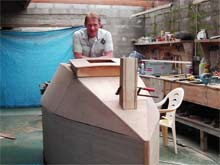 |
When I decided to take part in this extreme challenge called the Around in Ten I had no Hollywood style thoughts about becoming a celebrity or a “star” nor was I convinced that I could build, let alone design, a suitable boat for this task.
I believe that lack of knowledge can sometimes be a “blessing” in regard to “thinking out of the box” but very often this lack of knowledge leads you to the ultimate barrier of your dedication and ability to carry on.
I probably am the one participant with the least experience regarding sailing in general of the whole pack. Sure I have done my reading in the past but I’m realistic enough to know that being aware is not the same as being there.
Although some came very close in describing the magnitude of fear they encountered during their sea voyages, being there, feeling the shear strength of the gale and the thundering sound of braking waves is something that cannot be transferred to that little spot somewhere in our brain that control emotions, through words, written on paper.
 |
There is just a small trophy for he who succeeds in sailing around the globe in a ten foot sailboat and the knowledge that it was possible after all. |
I’m convinced that every participant in the AiT has his own reason (s) to be part of it and I would not be surprised that none of us have the same exact reason to do this.
There is just a small trophy for he who succeeds in sailing around the globe in a ten foot sailboat and the knowledge that it was possible after all.
Maybe that’s the only similarity between us, the desire of trying to show that it is possible.
How DO you go around designing/building a 10 ft off-shore sailboat, especially when you’re experience is marginal at it’s best?
First of all, I’m in this for the fun, nothing more-nothing less. I will try to do my utmost best to win this race but that’s it, and that’s all I can and will do.
I think I’m old enough to recognize my limitations and that’s probably the biggest asset I have. The intention to live a life after the AiT is well present so I WILL NOT push the limits just to win, but I will push the limits to survive.
| With the little knowledge I have regarding boat design I felt that it probably was best to stay with the things I knew and stay away from computer aided design programs, which I wouldn’t know how to use anyway. |
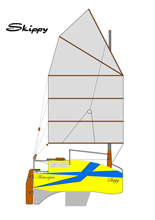 |
With the little knowledge I have regarding boat design I felt that it probably was best to stay with the things I knew and stay away from computer aided design programs, which I wouldn’t know how to use anyway.
Since I’m a “first time” boat builder, ease of construction was primary on the list together with an acceptable degree of comfort. These are probably the only two things that do not come into consideration when a professional designer would tackle this job I guess.
I don’t have the tools/knowledge to design/build an all composite light weight sailboat so plywood it would be. Simple demands call for simple solutions so the shape of the bottom was quickly lined out, a flat bottom is the easiest to build so a flat bottom it would be. The only advantage this would give me, apart from ease of construction, was that it would give the most room for the least volume. The LOA was determined by the rules of the AiT and the beam was simply the size of the width of some plywood sheets I had left over from a house building project, it was as simple as that.
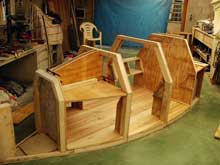 |
Simple demands call for simple solutions so the shape of the bottom was quickly lined out, a flat bottom is the easiest to build so a flat bottom it would be. |
After some “fiddling” I decided that the best choice would be to actually build the boat around me and not the other way round, build the boat according certain parameters and see if you can fit in it and/or adapt your “lifestyle” to it.
Another important factor to decide was: what concept would be used, the “Tinkerbelle” way with a small cabin and a rather large cockpit or the modern ”life boat” with an all enclosed cabin and no cockpit.
I opted for the second albeit a little modified. A deck at the stern, how small it would be, was a necessity for me and so a rather unusual shape was created.
With little else than a few sketchy drawings I started the build and at the beginning things seemed to go smoothly because you’re going from nothing to something. Soon all the bulkheads (4) where in place and I started to layout and build the lockers.
Later in the build, when the hull panels where attached, I regretted that I didn’t do more work on the inside when there was ample room to get in and out of the cockpit without doing some real climbing.
| Later in the build, when the hull panels where attached, I regretted that I didn’t do more work on the inside when there was ample room to get in and out of the cockpit without doing some real climbing. |
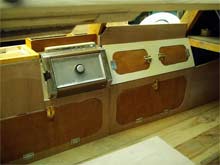 |
The plywood for the bottom was 18 mm outdoor grade plywood to be covered with two layers of 300 gr polyester. Since this worked for Gerry Spiess, who crossed the Atlantic in his 10 ft Yankee Girl, it also would work for me. The hull sides and cabin where cut out of 10 mm plywood sheet and everything went along without great difficulties. There’s no doubt in my mind that most, if not all, materials used for “Skippy” are way overkill for the task but I wanted a strong boat because I expected the skipper (me) to make some serious mistakes.
The sail rig was something that was decided upon rather quickly. I needed a rig that was easy to handle and if possible, easy to repair. A few sheets at the most to set and trim the sail, and easy to reef. The Chinese junk sail offered most of these requirements and so I opted for a junk sail for which the basic outline was kindly provided by John Tompkins of Great Britain, thanks John!!
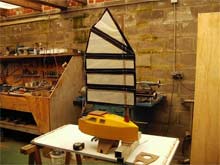 |
The Chinese junk sail offered most of these requirements and so I opted for a junk sail for which the basic outline was kindly provided by John Tompkins of Great Britain, thanks John!! |
There is no rivalry between the racers but we’re not close as brothers either. We don’t interfere with each others private situation so I only speak for myself regarding the following:
The only thing I knew when I stepped into this was that I had to make arrangements to take at least 1 ½ years of unpaid leave at work. I don’t know about the other racers but to me this will be the most difficult problem to solve. How do I pay the mortgage on the house and the other bills when I’m away? My wife and I felt from the beginning that before we could ask other people/company’s to participate, we had to take the first (financial) risk and build the boat at our own expense.
Now that this task is nearly completed I face the reality of having a boat and the desire but no resources to participate in the AiT.
The future will reveal if we made the right decision by building the boat first and not looking for sponsors first.
No matter how it goes, I have no regret that I took part in this challenge and would not have missed it for all the money in the world…… so to speak (grin-grin).
At age 53 and with a medical history, I feel that this might well be the last chance I have to participate in something that comes as close as possible to fulfill a dream.
I never was a big fan of the sophisticated, high tech, multimillion dollar event community and I probably never will be. My admiration for the “loner” has only grown throughout the years.
| Now that this task is nearly completed I face the reality of having a boat and the desire but no resources to participate in the AiT.
The future will reveal if we made the right decision by building the boat first and not looking for sponsors first. |
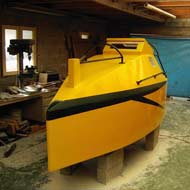 |
The AiT has his opponents, which is nothing more than normal I guess, but sometimes the arguments are ridiculous and not too the point.
There is always something to learn and perhaps, just perhaps, one day someone’s life can be saved due to the experience learned from this extreme challenge. Those who are convinced that there will be nothing to gain from the AiT are either afraid to learn that their prediction was completely wrong, or have the feeling that they hold all the wisdom. Both will lead to an eventual standstill of prosperity.
Years ago I had an older friend, Gerald Greenhow, who once told me:
“don’t ever put your self down, there are others who’ll gladly
do that for you and they are probably better at it also”.
“It’s better to fail than not to try”
Gilbert Van Meel |

